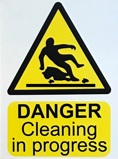Identify Floor Cleaning Slip Risks
Slip risks may arise from a lack of understanding of floor cleaning and can be immediate (wet or damp floor) and medium term and longer term (reduction of slip resistance). Among the “Big Six” sectors, cleaning is particularly associated with STF in healthcare, retail and industry.
Risks from a lack of understanding
Floor cleaning may be wrongly regarded as a simple task and not well understood
- “The effect of cleaning on slips is not well understood by workers in the cleaning sector” (The Efficacy of Cleaning Regimes)
- “The process of cleaning is not well understood by workers in the cleaning sector” (The Efficacy of Cleaning Regimes)
- Cleaners may not be aware that damp and drying floors can be very slippery
- Cleaners may not understand the importance of
- using the correct cleaning chemical (may be suggested by the flooring manufacturer)
- not using an incorrect cleaning chemical (which could damage the floor, e.g. pine oil on vinyl floors)
- using the correct amount of cleaning chemical (to avoid a residue of cleaning chemical)
- using the correct contact time between the cleaning solution and the floor (to allow the chemical to work)
- use of a rinse cycle if required by the flooring manufacturer (to avoid a residue of cleaning chemical)
- not using a polish (unless specifically required)
Risks from a wet or damp floor

Immediate risk during cleaning from a wet or damp slippery pedestrian surface
- Damp and "Mop-dry" floors can be particularly hazardous as they look dry but are still slippery
- Non-cleaners are the main slip victims
- The presence of a cleaner or sign(s) does not guarantee no slips
In 2009, the Slip STD Consortium proposed a classification for hard floors based on foreseeable contamination
In this video (6 min 7 sec), Steve Thorpe from HSL demonstrates pendulum slip resistance results of a dry floor, a wet floor and a “cleaned” floor
Risks of a reduction in slip-resistance
Where a floor has a good grip to start, the slip-resistance will normally reduce over time with use and wear-and-tear in line with the expected life of the flooring. However problems with cleaning and ineffective/incorrect cleaning can adversely affect slip-resistance.
Medium term failure to maintain slip resistance through
- A failure to remove contaminants through ineffective cleaning
- An accumulation of detergent because too much detergent is used
- Use of polish
Longer term reduction of slip resistance through
- Damage to the floor and it’s micro-roughness through incorrect cleaning, including
- Use of a detergent that actually damages the floor, e.g. pine oil can damage some vinyl floors
Assessment of Slip Risks from Floor Cleaning
Floor cleaning is an important part of Slip Risk Assessment and Prevention
A risk assessment approach to Floor Wet Cleaning slips (trips and falls) can include the following steps
- Identify Risks
- Communicate
- Replace
- Reschedule
- Equip
- Segregate

